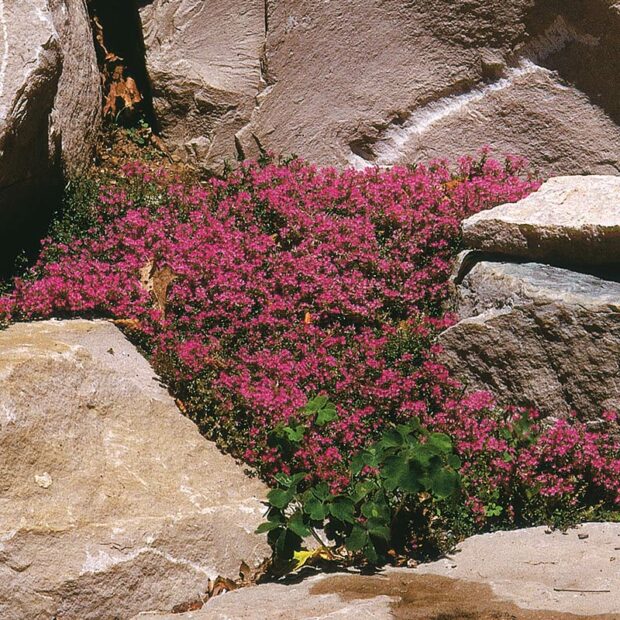
by George Papadelis
Of all the perennial plants we have available for April flowers, rock cress (Aubrieta) is one that combines beautifully with early season bulbs.
Aubrieta has the common names rock cress and false rock cress. This is an excellent example of when common names can be confusing. Another popular rock garden plant, Arabis, is also called rock cress. Our focus here will remain on Aubrieta, whose characteristics are similar to Arabis.
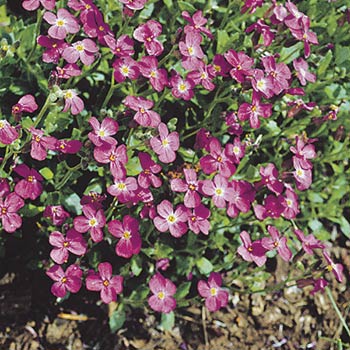
Aubrieta is considered an excellent rock garden plant. Rock gardens can vary, but this term typically describes sunny gardens with smaller, shorter plants that look good growing among rocks. Alpine plants are usually rock garden plants; however, the term “alpines” refers to plants that originate from mountains, above the timberline. They are always compact to better withstand strong winds and are happiest in well-drained “rocky” soil. This is a little confusing, but it is interesting to note that most alpines are rock garden plants, but rock garden plants are not necessarily alpines. Aubrieta is in fact an alpine plant that originated on the mountains of southern Europe and Turkey.
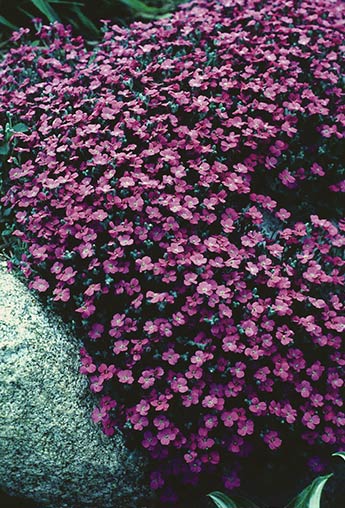
Aubrieta usually begins to bloom in mid to late April and continues into May. They bloom 4 to 6 weeks, which is twice as long as the popular creeping phlox. Plants rarely grow taller than six inches and may spread as far as 24 inches. Almost all aubrieta have mat-forming, gray-green leaves that hold their color and remain alive all four seasons. The only maintenance they may require is a light trim of the leaves after flowering is completed.
Their flowers are rarely over 3/4-inch wide, but are produced in masses. Flower colors include white, pink, red, blue, and violet. Many seed-grown varieties produce flowers in a range of colors. ‘Royal Blue,’ for example, has flowers of blue, lavender, and violet. ‘Royal Red’ has flowers in shades of red, purple, and magenta. For semi-double flowers, try ‘Bengal,’ which comes in shades of lavender, cerise, and purple. Some varieties are truly one color, such as the dark purple flowers of ‘Whitewell Gem’ and the fluorescent blue flowers of ‘Novalis Blue.’
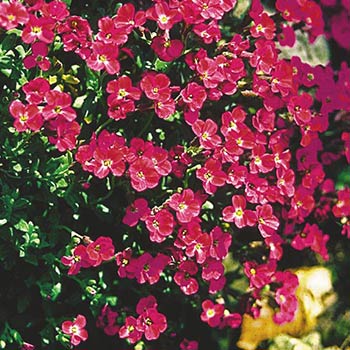
Some aubrieta are grown from cuttings to more perfectly reproduce the desirable characteristics of the parent. ‘Aurea,’ also called golden aubrieta, has gold-yellow leaves that provide another attractive feature long after its blue-violet flowers have faded. ‘Aurea Variegata’ has bright gold and green bicolored leaves topped with blue-violet flowers. ‘Argenteovariegata’ forms a extra dense, 2- to 4-inch tall mound of creamy yellow variegated foliage and bluish flowers.
There are several other rock garden or wall plants for sun that bloom about the same time as aubrieta. Some of the more popular ones include Arabis, candytuft, perennial alyssum, pasque flower, and cushion spurge. All of these are great companions for bulbs that, like aubrieta, prefer well-drained, slightly alkaline soil and full sun. The blues, purples, and reds of aubrieta make perfect companions for pink tulips or golden daffodils.
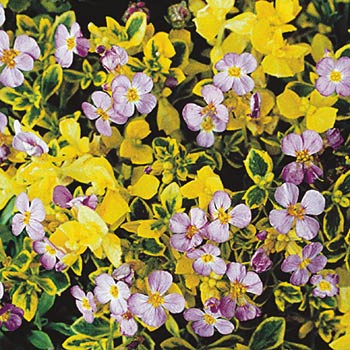
The well-known garden designer Lauren Springer created a beautiful combination in her garden using aubrieta. She planted it with blue-leafed, donkey-tail spurge (Euphorbia myrsinites). Its chartreuse flowers are planted with the purple flowers of rock cress in a dry corner of her yard. She writes “it is perhaps the most psychologically effective combination in the garden, setting the mood for advancing spring, filling me with delight and anticipation each time I go in and out of the otherwise still dormant garden.”
After a Michigan winter, I think it is especially important to celebrate the long-awaited spring. If you can find or create a well-drained sunny site, try using aubrieta to herald the promise of another gardening season—just like Lauren Springer.
Rock cress, false rock cress
Botanical name: Aubrieta deltoidea (aw-bree-EH-tuh del-TOY-dee-uh)
Plant type: Perennial
Plant size: Height: 6 inches / Width: 24 inches
Habit: Mat-forming mound
Hardiness: Zone 4
Flower colors: Purple, blue, violet, red, white and pink
Flower size: 3/4-inch wide
Bloom period: Mid April to May
Leaf color: Gray-green; some varieties are variegated
Light: Full sun
Soil: Well-drained, average fertility
Uses: Rock garden, wall garden, edge of perennial beds
Companion plants: Arabis, candytuft, perennial alyssum, pasque flower, cushion spurge, short tulips and daffodils
Remarks: To prevent legginess, cut back stems after flowering to allow new growth to emerge and maintain compactness.
George Papadelis is the owner of Telly’s Greenhouse in Troy and Shelby Township, MI.
